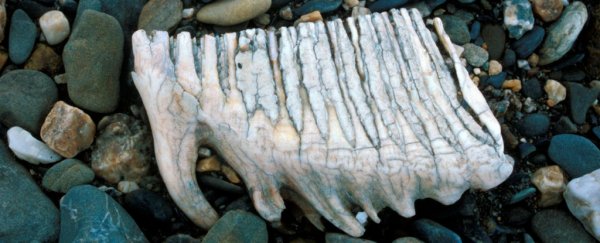When the last of Earth's woolly mammoths expired, they were isolated on Wrangel Island in the frigid Arctic Ocean, north of Russia. We've known of the species' last resting place for years; now, we finally know more about their survival and ultimate death.
Woolly mammoths (Mammuthus primigenius) died out 4,000 years ago over a remarkably short time period. A new analysis of their teeth and bones has brought us closer to understanding their rapid demise.
The end of the last ice age 11,700 years ago was the beginning of the end for the woolly mammoth; a warming climate and human hunting made for a deadly cocktail. Then, just under 10,000 years ago, the species was extinct from its extensive mainland habitat across Eurasia and North America.
In 2004, the animals were found to have continued clinging to a precarious existence on St Paul Island in the Alaskan waters of the Bering Sea until 5,700 years ago. But the longest that woolly mammoths survived was on Wrangel Island, according to the results of radiocarbon analysis published in 1995.
The international team of researchers set out to conduct isotope analysis on a large number of woolly mammoth teeth and bones from around the world to try and learn more about environmental changes these animals experienced.
As we have previously explained, some stable isotopes in the soil can be taken up into plants, which are then consumed by people and animals. The isotopes replace some of the calcium in teeth and bones; these can then be dated and matched to geographical locations or other changes.
By studying the isotopes of carbon, nitrogen, sulphur and strontium, the researchers, led by geochemist Laura Arppe of the Finnish Museum of Natural History, hoped to reconstruct changes in the natural environment by matching them to changes in the mammoths' diet and habitat.
For the woolly mammoths on the plains of Russia and Ukraine, as well as St Paul Island, the results were pretty consistent with extinction. Just prior to their demise, the isotopes in their bones changed dramatically - suggesting, in turn, a dramatic change in the mammoths' environment and diet.
But, strangely, the Wrangel Island population didn't show a change in collagen carbon and nitrogen isotopes 10,000 years ago, as would be expected of lives spent in a world warming up from the ice age.
There was a small increase in sulphur and strontium in Wrangel mammoths towards the end that suggested an increased weathering of the bedrock, but their isotopes did not change anywhere near as dramatically as those of other mammoth populations.
And there was something else. The carbon isotopes in the Wrangel Island mammoths were different from those of their Siberian ice age ancestors. Previous DNA analysis had suggested that the Wrangel Island mammoths had mutations that affected their fat metabolism.
The researchers believe these two pieces of evidence point to the same conclusion.
"We think this reflects the tendency of Siberian mammoths to rely on their reserves of fat to survive through the extremely harsh ice age winters, while Wrangel mammoths, living in milder conditions, simply didn't need to," Arppe said.
So, if they didn't experience the same environmental pressures as other mammoth populations, why did they die out so suddenly? The team believes that harsh, short-term weather events could have played a role - such as rain in winter, which could have frozen the ground and made food inaccessible, as we saw earlier this year with Svalbard reindeer.
From the 2017 DNA study, we know that the small and dwindling size of the Wrangel Island population was leading to detrimental genetic mutations, and the bedrock isotopes could also be indicative of a decline in drinking water quality.
"It's easy to imagine that the population, perhaps already weakened by genetic deterioration and drinking water quality issues could have succumbed after something like an extreme weather event," said geoscientist Hervé Bocherens of the University of Tübingen, Germany.
Researchers also can't fully rule out human activity as a contributing factor, although it seems they didn't arrive on the island until after the mammoths were already extinct.
We've seen first-hand how vulnerable an isolated population of island animals can be: just take the sad case of the Bramble Cay melomys who were declared extinct earlier this year as their habitat was destroyed by rising seawater.
Tracking the tale of the isolated death of the woolly mammoth emphasises the importance of ensuring genetic diversity in threatened and endangered species.
The research has been published in Quaternary Science Reviews.
